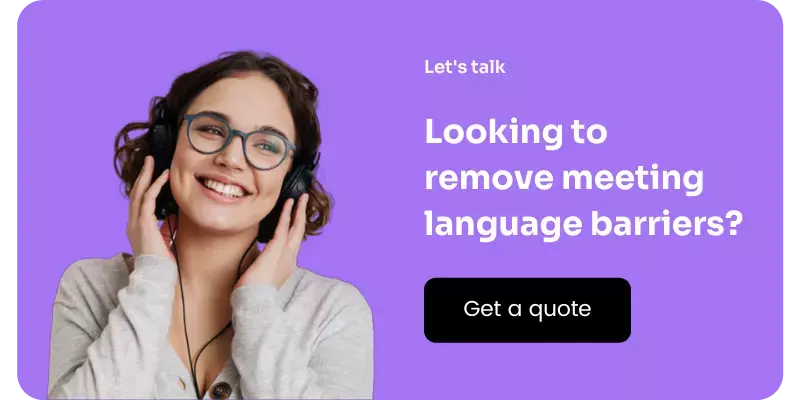The COVID-19 pandemic has changed the events industry status quo. And for companies to survive and thrive in our ‘new normal’, they need to rise to the challenge of hosting smooth, engaging events in virtual environments.
This means leveraging digital tools and technology to achieve higher attendance and engagement rates — because whether online or offline, event success depends on how effective your promotion is.
With change comes opportunity
The global landscape changed in the blink of an eye, with virtually every industry having to adapt rapidly to maintain productivity. For the events sector in particular, the global pandemic and its associated restrictions have been incredibly disruptive.
Across the world organisers were left scrambling. In-person events were reconfigured into virtual conferences at the drop of a hat, with some events — such as multilingual conferences — being harder to pull off than others, due to the significant difference in scale.
For the foreseeable future, events that typically had people flying in from all corners of the world are off of the table. This leaves organisers with a double conundrum:
- How to host an engaging, interactive online event that caters to international attendees.
- How to effectively promote said event on a global scale, with messaging that resonates with different nationalities.
Effective promotional tactics to get the word out
Where to begin?
You don’t want to blindly promote your event on-the-fly. Therefore, devising a promotional roadmap is a good place to start. This blueprint should include:
- Preparation. Preparation of promotional material, role designation and selecting channels (such as Facebook, LinkedIn and Instagram).
- Pre-event promotion. Identifying decision makers and thought leaders to share the event, as well as creating a content calendar that can be used to deploy relevant messaging in the run-up to the big day.
- Promotion during the event. Selecting an experienced social media manager to monitor your social media channels and share live insights as they happen.
- Post-event promotion. Creating video clips of event highlights, sharing slides and documentation and sending out ‘thank you’ emails to all attendees.
This ‘skeleton of promotional ideas’ should be solid enough to be used throughout the campaign, and flexible enough to allow for new ideas or adjustments. Once you’ve got your ‘bare bones’ foundation in place, you can move onto implementation.
Rolling out a promotional campaign for a multilingual online event
Promoting an online event for a multinational audience can be a challenge. Thankfully, the digital sphere offers a number of ways that you can reach and engage people in different countries.
1. A compelling events landing page
To market to multinational audiences, set up an events landing page that uses smart content and has multilingual functionality. Your landing page design must be visually appealing and aligned with the look-and-feel of other event promotional material.
For content population, consider including video clips of keynote speakers, information of what attendees can expect on the day, as well as dates, event itinerary and pay portal links.
2. Keyword research and SEO best practices
Keyword research can enrich your on-page SEO and help the right people find your event. It’s a good idea to employ the services of a specialist, who’ll research and choose the best keywords and phrases to include in the copy of your promotional material. If your budget doesn’t allow for an SEO specialist, you can use Google’s Keyword Planner to identify keywords and search phrases.
If the budget does allow for broader search strategies, consider casting your net wider by using search engines from other countries. For example, you could use Baidu — China’s most-used search engine — if you’re expecting a good number of attendees from that country.
3. A little help from your friends
Your greatest promotional tools are the people involved with your online multilingual event. Have your keynote speakers, hosts and employees promote the event via their social channels and websites (if they have them). To ensure cohesion and a level of control over what’s released, supply your promoters with assets like video, imagery and tracking URLs to see where traffic is coming from.
4. Email marketing and social media
Collate your contacts and segment them by country/language so that you can deliver email marketing to different audiences. This allows you to tailor your communications to the language of each segment, which is something that potential attendees from different countries will appreciate.
Use social media and focus on how each channel can be harnessed for maximum effect. For example, Instagram’s strength lies in the power of compelling imagery, while Twitter’s platform is ideal for real-time posts during the live event.
Visual and content consistency across all promotional efforts is important, and don’t forget to track the data you gather throughout your campaign. This valuable information can be used for future events.
Choose the right tools and promote them as part of the experience
For a virtual multilingual event to provide attendees with a positive experience, the platform and technology solutions need to work together. Organisers should promote the technology they’re using to assure attendees they can expect a seamless, glitch-free experience.
Virtual platforms offer premium tools that take your digital experiences to the next level with engaging, interactive and data-rich webinars that connect with your audiences and accelerate buying journeys. Tools such as these help event organisers convert engagement into revenue with interactive webinars, virtual events and multimedia content experiences.
And what about real-time translation for multilingual audiences? This is especially important as attendees from different countries will want a guarantee beforehand that their language of preference will be catered for.
Can you imagine paying for and attending an event that restricted engagement and left you struggling to understand what was being said?
Translation services for the virtual era
From remote simultaneous interpretation (RSI) and encrypted real-time audio streaming, to live captioning and recordings in multiple languages, a best-of-breed RSI platform will work well with your chosen platform to deliver an experience that everyone can enjoy.
Interprefy is one such platform. As the leading RSI solution, our patented translation and participation technology is cost-effective, rapidly deployable and promises virtually no latency. With Interprefy, you can expect:
- Crystal-clear, encrypted audio with almost zero latency, as well as audio and video synchronisation.
- A intuitive interface for interpreters to access the source video and audio, set up relay languages and communicate with their virtual booth partners.
- Compatibility with almost any virtual meeting, events and streaming platforms.
- An intuitive system that requires no configuration and can be scaled to meet the requirements of any online multilingual event, be it a webinar or virtual conference.
For an online multilingual event to be a success, myriad moving parts need to work in unison. With Interprefy’s experience and best-in-class software, event organisers can be assured their translation requirements are in good hands. Get firsthand experience of our RSI tools and talk to us about your upcoming event — click the button below to find out more.











 More download links
More download links



